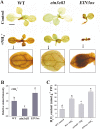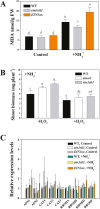The Arabidopsis AMOT1/EIN3 gene plays an important role in the amelioration of ammonium toxicity
- PMID: 30689938
- PMCID: PMC6382331
- DOI: 10.1093/jxb/ery457
The Arabidopsis AMOT1/EIN3 gene plays an important role in the amelioration of ammonium toxicity
Abstract
Ammonium (NH4+) toxicity inhibits shoot growth in Arabidopsis, but the underlying mechanisms remain poorly characterized. Here, we show that a novel Arabidopsis mutant, ammonium tolerance 1 (amot1), exhibits enhanced shoot growth tolerance to NH4+. Molecular cloning revealed that amot1 is a new allele of EIN3, a key regulator of ethylene responses. The amot1 mutant and the allelic ein3-1 mutants show greater NH4+ tolerance than the wild type. Moreover, transgenic plants overexpressing EIN3 (EIN3ox) are more sensitive to NH4+ toxicity The ethylene precursor 1-aminocyclopropane-1-carboxylic acid (ACC) increases shoot sensitivity to NH4+, whereas the ethylene perception inhibitor Ag+ decreases sensitivity. NH4+ induces ACC and ethylene accumulation. Furthermore, ethylene-insensitive mutants such as etr1-3 and ein3eil1 display enhanced NH4+ tolerance. In contrast, the ethylene overproduction mutant eto1-1 exhibits decreased ammonium tolerance. AMOT1/EIN3 positively regulates shoot ROS accumulation, leading to oxidative stress under NH4+ stress, a trait that may be related to increased expression of peroxidase-encoding genes. These findings demonstrate the role of AMOT1/EIN3 in NH4+ tolerance and confirm the strong link between NH4+ toxicity symptoms and the accumulation of hydrogen peroxide.
Keywords: amot1 mutant; AMOT1/EIN3; Ammonium stress; Arabidopsis; H2O2; peroxidases.
© The Author(s) 2019. Published by Oxford University Press on behalf of the Society for Experimental Biology.
Figures









Similar articles
-
Ethylene signaling negatively regulates freezing tolerance by repressing expression of CBF and type-A ARR genes in Arabidopsis.Plant Cell. 2012 Jun;24(6):2578-95. doi: 10.1105/tpc.112.098640. Epub 2012 Jun 15. Plant Cell. 2012. PMID: 22706288 Free PMC article.
-
OsEIL1, a rice homolog of the Arabidopsis EIN3 regulates the ethylene response as a positive component.Plant Mol Biol. 2006 May;61(1-2):141-52. doi: 10.1007/s11103-005-6184-1. Plant Mol Biol. 2006. PMID: 16786297
-
Ethylene signaling in Arabidopsis involves feedback regulation via the elaborate control of EBF2 expression by EIN3.Plant J. 2008 Sep;55(5):821-31. doi: 10.1111/j.1365-313X.2008.03551.x. Epub 2008 May 9. Plant J. 2008. PMID: 18466304
-
Review: Mechanisms of ammonium toxicity and the quest for tolerance.Plant Sci. 2016 Jul;248:92-101. doi: 10.1016/j.plantsci.2016.04.008. Epub 2016 Apr 20. Plant Sci. 2016. PMID: 27181951 Review.
-
Shaping Ethylene Response: The Role of EIN3/EIL1 Transcription Factors.Front Plant Sci. 2019 Aug 26;10:1030. doi: 10.3389/fpls.2019.01030. eCollection 2019. Front Plant Sci. 2019. PMID: 31507622 Free PMC article. Review.
Cited by
-
The Arabidopsis Receptor-like Kinase CAP1 Promotes Shoot Growth under Ammonium Stress.Biology (Basel). 2022 Oct 2;11(10):1452. doi: 10.3390/biology11101452. Biology (Basel). 2022. PMID: 36290356 Free PMC article.
-
Transcripts related with ammonium use and effects of gibberellin on expressions of the transcripts responding to ammonium in two invasive and native Xanthium species.Front Plant Sci. 2022 Oct 26;13:1035137. doi: 10.3389/fpls.2022.1035137. eCollection 2022. Front Plant Sci. 2022. PMID: 36388472 Free PMC article.
-
The dissection of tomato flavor: biochemistry, genetics, and omics.Front Plant Sci. 2023 Jun 6;14:1144113. doi: 10.3389/fpls.2023.1144113. eCollection 2023. Front Plant Sci. 2023. PMID: 37346138 Free PMC article. Review.
-
Bicarbonate-Dependent Detoxification by Mitigating Ammonium-Induced Hypoxic Stress in Triticum aestivum Root.Biology (Basel). 2024 Feb 5;13(2):101. doi: 10.3390/biology13020101. Biology (Basel). 2024. PMID: 38392319 Free PMC article.
-
The TabHLH094-TaMYC8 complex mediates the cadmium response in wheat.Mol Breed. 2023 Jul 12;43(7):57. doi: 10.1007/s11032-023-01404-1. eCollection 2023 Jul. Mol Breed. 2023. PMID: 37457120 Free PMC article.
References
Publication types
MeSH terms
Substances
LinkOut - more resources
Full Text Sources
Molecular Biology Databases

